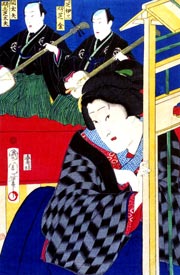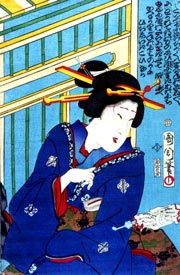| UME GOYOMI |
| Play titles | Shunshoku Ume Goyomi Ume Goyomi Tatsumi no Sono |
|||||||||||||||
| Authors | Tamenaga Shunsui (original novel) Kimura Kinka (script) |
|||||||||||||||
| History |
"Shunshoku Ume Goyomi" was a very successful ninj˘bon written by Tamenaga Shunsui and published in Edo in 1833. It was adapted for Kabuki several times in the 1860s and 1870s: |
|||||||||||||||
"Ume Goyomi Tatsumi no Sono" was the first Kabuki drama to use an Utazawa ensemble for musical accompaniment. |
||||||||||||||||
|
Kimura Kinka wrote his own script, which was staged in July 1927 at the Kabukiza [casting]. |
||||||||||||||||
| Structure |
"Ume Goyomi" is made up of 3 acts. |
|||||||||||||||
| Key words | Sewamono Shinkabuki Ninj˘bon Fukagawa |
|||||||||||||||
| Summary |
The main story concerns the rivalry between Adakichi and Yonehachi, two geisha of the Fukagawa district of Edo, for the love of the handsome and gentle Tanjir˘. This situation gives rise to a number of highly entertaining scenes when, for example, in a fit of jealous rage Yonehachi tramples on the brand new haori coat that Adakichi has just presented to Tanjir˘, or when, by way of revenge, Adakichi manages to beat Yonehachi over the head with a geta clog in an amusing parody from the famous highlight from "Kagamiyama Koky˘ no Nishikie". Courtesy of Paul M. Griffith |
|||||||||||||||
| Comments |
In recent years it's become a popular vehicle for the combined talents of Band˘ Tamasabur˘ and Nakamura Kankur˘ in the leading roles of the two geisha, Adakichi and Yonehachi. Both Tamasabur˘ and Kankur˘ are ideal for their parts and Tamasabur˘ is here the personification of 19th century "chic". The geisha of the Fukagawa district of Edo, (the old name for T˘ky˘), where this tale is set, were famous for their stylishness and cheeky pride and Tamasabur˘ plays this to perfection. It comes through not only in the way he looks and speaks, but also in superb little touches of acting as, for example, when Adakichi must remove the threads from the new haori before Tanjir˘ can try it on. This involves miming the actions and Tamasabur˘ does this so accurately and convincingly that the audience usually can't help but laugh with pleasure. Kankur˘ too, is excellent as the slightly coarser geisha Yonehachi and demonstrates his abilities in female roles beautifully. As a pair the two actors are very well balanced. Courtesy of Paul M. Griffith (1997) |
|||||||||||||||
 |
 |
 |
|
The actors ďtani Hiroji V, Band˘ Mitsugor˘ VI and Onoe Kikugor˘ V playing the roles of Adahachi, Yonehachi and Tanjir˘ in the drama "Ume Goyomi Tatsumi no Sono", which was staged at the Nakamuraza in the 3rd lunar month of 1870 (print made by Toyohara Kunichika) |
||
|
|
| Contact | Main | Top | Updates | Actors | Plays | Playwrights | Programs | Links | FAQ | Glossary | Chronology | Illustrations | Prints | Characters | Derivatives | Theaters | Coming soon | News |